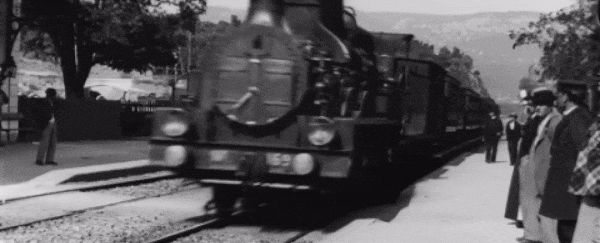Released in 1896, L'arrivée d'un train en gare de La Ciotat is one of the earliest examples of movie-making we have – the 50-second silent short, which shows a mail train pulling into La Ciotat station, seems humdrum by today's standards, but would have wowed 19th century crowds seeing moving pictures for the first time.
Now this famously old, scratchy film relic has been upscaled into glorious 60 frames-per-second 4K footage thanks to the power of artificial intelligence – using neural networks to fill in missing pixels and missing frames that weren't there to begin with.
It's the work of developer and YouTuber Denis Shiryaev, and if you watch his new take it comes across as a modern-day movie filmed in black and white. Details on clothing and the train itself can be easily picked out; everything runs smoothly and in sync; and you can see far into the distance.
As well as adding a new audio track, Shiryaev has used two algorithms here: the first is the Gigapixel AI from Topaz Labs, which fills in detail as pictures are made larger.
It does this by analysing huge numbers of images as they are scaled down, learning what information gets lost along the way. With this training to draw on, the AI is able to work backwards to add information as images are scaled up.
The second bit of AI magic is added by DAIN (or Depth-Aware Video Frame Interpolation), developed by a team of researchers and Google engineers.
DAIN also fills in detail, like Gigapixel AI, but this time it's it's inserting whole pictures rather than individual pixels, building the frame rate up to a smooth 60 frames per second.
Again, it's using an archive of existing videos as training materials, trying to work out what should be in the gaps by assessing both the before and after frames, and the different levels of depth that are in a shot.
Bear in mind that the extra details you're seeing in this restoration may not actually be what was really in the footage, down to the last pixel – instead they're the best guesses of computer algorithms trained on vast libraries of similar photos and videos.
The original L'arrivée d'un train en gare de La Ciotat was filmed by the Lumière brothers, using 35mm film inside a Cinématographe camera (which also doubled as a projector).
We should also point out that compared to some very poor-looking, low-resolution copies of the film online, the source video Shiryaev used is also of a very good quality, likely thanks to previous restoration techniques.
Unfortunately, the source video doesn't come with any details about how it was made, but it looks to have been digitally enhanced in some way.
Whatever the story behind the source used, the new version adds extra resolution and smoothness to the footage, giving us another example of how AI engines can construct their own digital reality.
While there are valid concerns about deepfake photos and videos – recreating scenes that never existed – this upscaling of a classic silent film shows the positive ways that neural networks can be deployed.
Check out some of the older versions of L'arrivée d'un train en gare de La Ciotat floating around YouTube, and you can see what a difference digital processing and artificial enhancements can make. The film is even available in colour now too.
